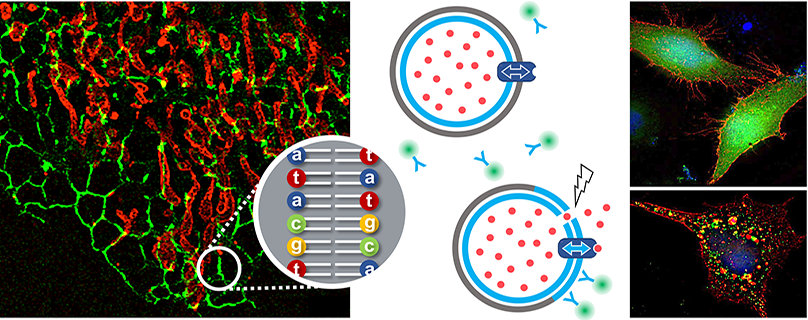Main content
Top content

Organellar lipid codes
The identity and function of cellular organelles critically relies on information encoded in their lipid bilayers. In the Holthuis lab, we study the functional implications of, and compensatory cellular responses to disease-induced imbalances in organellar lipid codes, with a main focus on aberrant distributions of sphingolipids. As approach, we develop disease-relevant cell models and exploit functionalized lipid probes to interrogate organellar lipid codes and capture novel lipid effector proteins.
Research topics
- Tumor suppressor lipids
- Sphingolipid-mediated membrane repair
- Plasticity and biological impact of organellar lipid codes
- Protein-lipid crosstalk
Model systems
- Genetically engineered cell-lines
- Reconstituted membrane systems
- Cell-free produced membrane proteins
Methods
- Live-cell imaging
- Genetic engineering
- Organellar lipidomics
- Light-operated lipid probes
- Switchable lipid transfer proteins
- Functional reconstitution of membrane proteins
Selected publications
Niekamp P, Scharte F, Sokoya T, Vittadello L, Kim Y, Deng Y, Südhoff E, Hilderink A, Imlau M, Clarke CJ, Hensel M, Burd CG, Holthuis JCM (2022) Ca2+-activated sphingomyelin scrambling and turnover mediate ESCRT-independent lysosomal repair. Nature Communications 13:1875, doi: 10.1038/s41467-022-29481-4. pdf
Sokoya T, Parolek J, Foged MM, Danylchuk DI, Bozan M, Sarkar B, Hilderink A, Philippi M, Botto LD, Terhal PA, Mäkitie O, Piehler J, Kim Y, Burd CG, Klymchenko AS, Maeda K, Holthuis JCM (2022) Pathogenic variants of sphingomyelin synthase SMS2 disrupt lipid landscapes in the secretory pathway. Elife. 11:e79278. pdf
Dadsena S, Bockelmann S, Mina JG, Hassan D, Korneev S, Razzera G, Jahn H, Niekamp P, Müller D, Schneider M, Tafesse FG, Marrink SJ, Melo MN & Holthuis JCM (2019) Ceramides bind VDAC2 to trigger mitochondrial apoptosis. Nat Commun 10, 1832, doi: 10.1038/s41467-019-09654-4. pdf
More information
Click here to go to the homepage of the Molecular Cell Biology group








